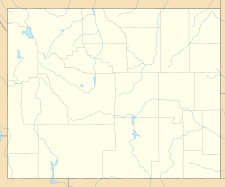Downs Glacier facts for kids
Quick facts for kids Downs Glacier |
|
|---|---|
| Type | Mountain glacier |
| Coordinates | 43°17′41″N 109°39′49″W / 43.29472°N 109.66361°W |
| Area | 155 acres (63 ha) |
| Length | .70 mi (1.13 km) |
| Width | .35 mi (0.56 km) |
| Terminus | moraine |
| Status | unknown |
Downs Glacier is a cool natural ice formation found high up in the Shoshone National Forest in Wyoming, USA. It's located on the eastern side of the Continental Divide, which is like a giant natural line that separates rivers flowing to the Pacific Ocean from those flowing to the Atlantic. This glacier is part of the amazing Wind River Range mountains. Downs Glacier is special because it's one of many glaciers in the Fitzpatrick Wilderness, and together, these glaciers form the biggest group of glaciers in the American Rocky Mountains.
Contents
What is a Glacier?
A glacier is a huge, slow-moving river of ice. It forms over many years as layers of snow pile up and get compressed into ice. Glaciers are found in places where it's cold enough for snow to stay on the ground all year round. They slowly flow downhill because of gravity.
How Glaciers Form
Glaciers start as snowflakes. When more snow falls in winter than melts in summer, it begins to build up. Over time, the weight of new snow squeezes the older snow. This pressure turns the fluffy snow into a denser, granular ice called firn. If more snow keeps piling up, the firn gets even more compressed and turns into solid glacial ice.
Types of Glaciers
There are different kinds of glaciers. Downs Glacier is a mountain glacier, also known as an alpine glacier. These glaciers form in mountain valleys and flow down the slopes. Other types include ice sheets, which are massive layers of ice covering large land areas, like in Greenland or Antarctica.
Where is Downs Glacier Located?
Downs Glacier is nestled in a beautiful and wild part of Wyoming. It's about 1 mi (1.6 km) south of a peak called Downs Mountain. The glacier sits at a very high elevation, between 12,600 and 11,200 ft (3,800 and 3,400 m) above sea level. Imagine standing on top of a tall building; this glacier is much, much higher!
The Wind River Range
The Wind River Range is a rugged mountain range in western Wyoming. It's known for its stunning peaks, clear lakes, and many glaciers. This area is part of the larger Rocky Mountains system that stretches across North America. The Wind River Range is a popular spot for hiking and climbing.
Shoshone National Forest
Downs Glacier is located within the Shoshone National Forest. This forest was the very first national forest in the United States, created in 1891. It covers a huge area and is home to lots of wildlife, including bears, elk, and moose. It's a protected area, which means its natural beauty and ecosystems are preserved.
The Continental Divide
The Continental Divide is a special line that runs through the Americas. On one side, rivers and streams flow towards the Pacific Ocean. On the other side, they flow towards the Atlantic Ocean or the Gulf of Mexico. Downs Glacier is on the eastern side, meaning its meltwater eventually makes its way to the Atlantic.
Why is Downs Glacier Important?
Downs Glacier, like other glaciers, is a vital part of its environment. It acts like a natural water reservoir, storing frozen water that slowly melts during warmer months. This meltwater feeds streams and rivers, providing fresh water for plants, animals, and even people downstream.
Part of the Fitzpatrick Wilderness
The glacier is located in the Fitzpatrick Wilderness. A wilderness area is a special place where the land is kept as natural as possible, with very few human changes. This helps protect the unique plants and animals that live there. Being in a wilderness area means Downs Glacier is part of a pristine, untouched landscape.
Glaciers as Climate Indicators
Glaciers are also important for scientists. They are like giant thermometers that can tell us about Earth's climate history. By studying how glaciers grow and shrink, scientists can learn about past temperatures and rainfall. Today, many glaciers around the world are shrinking, which helps scientists understand changes in our climate.


